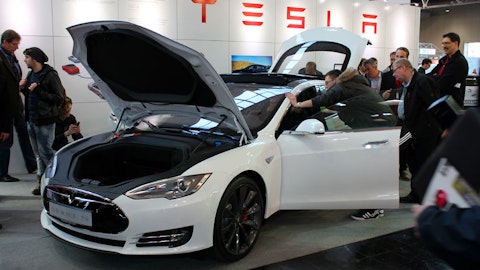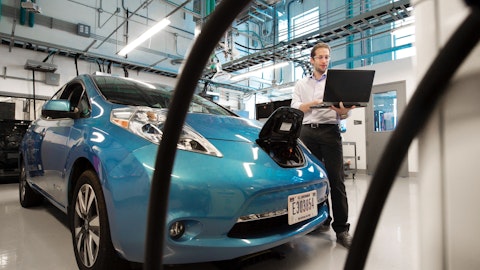Phil Horlock: That’s a good question. I’ve heard that some others about some folks out there have had cancellations on their request. I can tell you this, we’ve had two vehicle cancellations, two in total. Not 20, not two customers with lots of applicant, two vehicles because of a customer who was just concerned about, could he get the infrastructure in place the time he wanted it. And that’s it, that’s for us. We’ve been very successful in terms of putting our grant requests in highly validated, highly qualified. So, we feel good about that.
Mike Shlisky: Got it. One topic that wasn’t really mentioned was the organized labor in your facility. I was wondering if you could update us on how discussions might be going with your employees and what — if there is a date or a possible milestone you’ve got for us to share today on that. Thank you.
Phil Horlock: Okay. Well, I think it’s pretty much the same as I said last quarter, actually. We’re collaborating well with the United Steelworkers. We’re having very frequent negotiations. We’re not actually talking about what I call the economic terms. It’s been more around things like holidays and what do we do about grievance issues that might be out there. More of a typical what they call non-economic factors. So, as I said, going very well, a lot of good discussion, very professionally run. And I would say that I think the earliest we’re going to be talking — we seeing a completion of this, I don’t even have a date on it, but I think we’re talking well into ’24 before something might be finalized. Like I said, meeting very regularly, we’re very thorough.
This is a ground up program. I mean, you start literally from a blank sheet of paper and work through everything with United Steelworkers. And so, I think sometime, maybe towards middle of next year could be, but again, I’m not putting any timeframe on that. We’ll just do it thorough — we’ll just handle it thoroughly.
Mike Shlisky: Okay. Phil, thanks so much. I appreciate the commentary. I’ll pass it along.
Phil Horlock: You bet. Thanks, Mike.
Operator: Our next question comes from Craig Irwin with ROTH MKM. Please proceed.
Craig Irwin: Good evening, and thanks for taking my questions.
Phil Horlock: Hi, Craig.
Craig Irwin: Phil, you guys — hi. You guys have really demonstrated leadership in alternative fuels over the last many years. And part of that is understanding the market. And today again on this call, you’ve been really clear that the long-term adoption of EV school buses, the accelerating adoption is dependent on the ability to reduce the cost of operating these buses, the cost of acquiring these buses for the school districts that are considering going electric. Can you maybe share with us your level of activity, your level of engineering focus on reducing the cost of EV school buses for your customers? Maybe if you could share opportunities you see as particularly ripe or having good near-term returns? And what’s your vision for potential cost improvement over the next few years?
Phil Horlock: Okay. Great question, Craig. So, obviously, you look at where we are, we buy a system from Cummins, right, and they’re a great partner of ours. We buy our drivetrain system from them, includes the batteries, includes the controls, the control software system, the motor, the inverters, all the pieces. And we have a regular cadence with Cummins in terms of the products that we meet on going through options to reduce design, lower the cost, think smarter about the product itself. And I’m not going to put any numbers on the table now. Needless to say, we have a great program with them. We’re constantly looking at resourcing, sourcing alternatives, lower cost systems, whether that includes batteries, the control motor itself, do we look at the axles down the road.
I mean, these are all things we consider in collaboration with Cummins. I think we’re still at the early stages, I would say, in terms of the EV capability. And we’ve been in since 2018 with Cummins as our partner. But I think down the road, you’ll sort of look at it — we’ll be looking more and more at battery suppliers, battery alternatives, cell providers because frankly what’s happened in the last with one of our major battery suppliers on that was a battery supplier out there who had to declare bankruptcy and was acquired by another company is an example I think of some of the flux that’s going on there. So, we’re constantly looking at alternatives for stronger partners, better cost partners, lower cost partners, more efficient partners, and we’ll keep doing that.
I think some things over time, you’ll see us probably bring a little bit more of this in-house too as we get more scale on our business. But we’re at the forefront of it. We’re very collaborative with Cummins. They’re a great partner to work with, and I think you see it — see the outcome in our results. I do think that over this — over the next few years you’re definitely seeing not only the battery costs coming down but other components as a more scale and electrification of school buses and trucks in general and we want to capitalize and be ready for it. Hence, this generate capital venture we’ve done, Clean Bus Solutions, is again trying to make it more affordable on a regular, predictable, monthly basis, taking away what we call anxiety.
Anxiety for infrastructure away from the customer and we’ll handle it for them and take care of it and make it much easier for them to adopt electric buses. That’s what we learned a lot from propane. A little lengthy here the process Craig but I know you know our business very well. You’ve been with us a long time. One thing we did with propane was when we first entered that market, first question, where do I get propane from? What tank do I need? What threading do I need? You have to explain that and educate and train the drivers, the customers about how to handle these vehicles. I think we do a good job in that regard.
Craig Irwin: Excellent. And then I guess others have tried this question, so maybe we’ll be just a little more direct, right? You have the most experienced bid team out there facing the EPA, right? And you’ve demonstrated clear leadership in EV school buses. Do you expect to have a greater share of the $400 million in funding coming to customers that you support than what you saw on the $1 billion that was handed out last year?
Phil Horlock: That’s an interesting question. I can tell you this, I’m not quite sure what’s going to happen in the end, right? At the end, we don’t select the actual folks who are going to get those grants. I mean, the EPA says that. I will tell you, I think we prepared extremely well for it. Just to reiterate, we’ve sent in enough applications to take the entire fund. So, we think we did — and we really well qualified our applicants. We didn’t go in here with just a, “Hey, let me just give you a free opportunity to have a bus that’s relatively low cost or no cost.” We actually went thoroughly through every school district, everyone of our customers, some of them were conquest customers, new customers who wanted to move to Blue Bird. So, I guess what I’m saying is, Craig, that the proof of the pudding will be in the eating, right, when it shows up. But I feel confident we prepared as best we possibly could to get every opportunity to capitalize on these grants.


